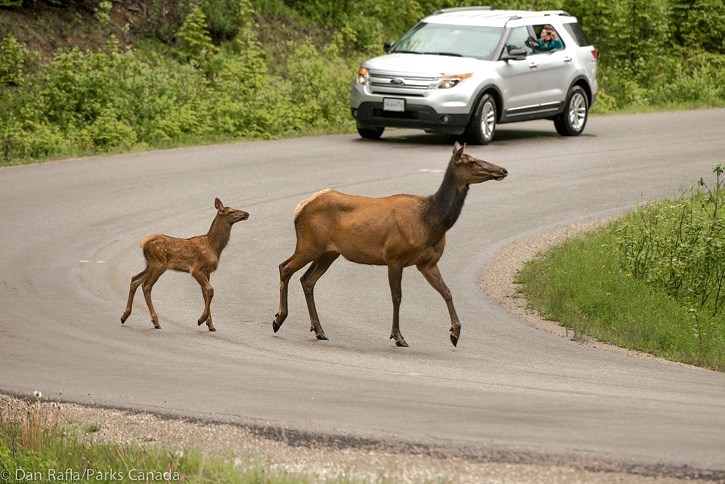BANFF – A cow elk protecting her newborn calf charged at two hikers and a cyclist near Surprise Corner late last week, signalling the elk calving season is well underway.
At this time of year until about the end of June, cow elk typically use areas closer to the Banff townsite as a refuge to avoid predators like wolves, cougars and bears during calving season.
Parks Canada wildlife experts say there were no injuries as a result of the two separate elk charging incidents.
They say the week-old calf was relocated to a closed area nearby on Tunnel Mountain for public safety reasons and to give both mama and baby space and security.
“We did what we call a grab-and-go where we basically will remove the calf,” said Mike Grande, resource management officer for Banff National Park.
“We had a closed area up on Tunnel Mountain that we could move the calf into and then reunite the cow with the calf and all was well.”
The west slope of Tunnel Mountain south of the Tunnel Mountain Trail was closed May 15 due to elk calving and is not due to reopen until June 30. The area lies within important calving grounds due to relatively low levels of human use.
“We’re right in the heart of the elk calving season right now,” said Grande.
Elk should not be mistaken for tame animals just because they’re in town, on the golf course, trails or playing fields. Cow elk can be aggressive when protecting their newborn calves by charging or striking with sharp hooves.
A newborn calf can stand within 30 minutes to an hour of being born, but remains defenceless against predators for the first few weeks of its life. Because of this, cow elk keep the newborns well hidden in bushes and shrubs, but they always stand guard not too far away.
A cow elk will lick the calf to make sure it is perfectly clean and clear of any smells that could attract predators like wolves, bears or cougars, and while this keeps them well camouflaged from predators, it often means that calves are difficult for people to see.
“The cows will drop their calves and they’ll stash them in the grass and the females will wander off at distance grazing and feeding,” said Grande.
“Someone may inadvertently walk between them and the calf and the cow will interpret that as a threat, and then they’ll come charging in.”
Bears in Banff have been known to hunt elk calves and deer fawns on the outskirts of the Banff townsite, prompting wildlife experts to also remind folks that bears have emerged from their winter dens.
“With it not really being too green up at much higher elevations just due to the temperatures and early spring, that's keeping ungulates down here,” said Grande.
“Other predators like wolves and cougars will also end up spending a lot more time down here in the valley bottom because that’s where their prey is.”
Grande said there have been primarily black bears around town, noting there is as many as 12 different bears between Castle Junction and Tunnel Mountain.
He said the wildlife team has had to haze some black bears, including one from Village I at Tunnel Mountain campground on Monday (May 29).
“It was quite skittish and basically took off without almost any hazing,” said Grande. “Just an officer presence was enough to get him out of there.”
Grizzly bears are also out and about, but Grande said bear 122, the patriarch of bears in the park known as The Boss, has been spending time further west.
“We had a couple of sightings of 122, which is his MO, where he’ll come down from his upper den location, hit the tracks and go all the way out towards Canmore and then back towards Lake Louise,” said Grande.
“He’ll maybe do that trip once or twice and then he’ll kind of follow the green wave as it’s known, following the green up higher and higher as he follows the snowline. We’ll see him once or twice over the summer and then at the end of the fall he’s here again.”
As for No. 136, the notorious male bear known as Split Lip for his disfigured mouth, he is a little bit more low key.
“There was a reported sighting a few weeks back, but nothing we could confirm,” said Grande, noting a photo of the grizzly was too blurry to categorically determine it was Split Lip.
As for the Bow Valley wolf pack, Grande said there are no sightings of any wolf pups yet, which are likely still in the den. The pack is believed to have at least five members right now.
However, members of the pack were spotted feasting on an elk carcass along Carrot Creek last week.
In this case, the wildlife team decided to remove the carcass, which was highly visible from the Trans-Canada Highway just west of the national park’s east gates.
Grande said the kill was located in a voluntary closure.
“We ended up pulling that carcass because there’s an active trail that goes into it, and unless we put up a closure, we couldn’t guarantee we wouldn’t be getting people in that area,” he said.
Parks Canada reminds people to travel in groups, pay close attention to any signs of wildlife, carry bear spray in an easily accessible place – and know how to use it.
Grande said it is mandatory to keep dogs on a leash.
“Keeping dogs on leash is huge, especially for the elk calving season,” he said.
“Dogs can really aggravate and agitate the cow elk and you’ll definitely elicit a stronger response with a dog.”
All carnivore sightings, or elk within the townsite, should be reported to Banff National Park dispatch at 403-762-1470.




